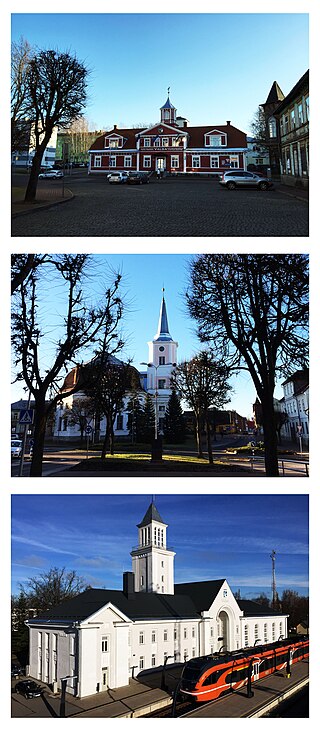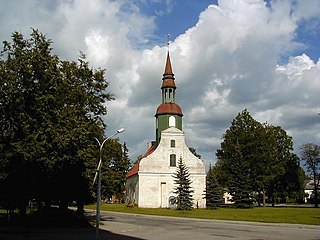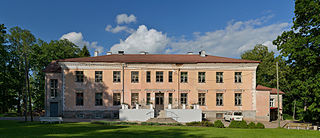
Valga is a town in southern Estonia and the capital of Valga County and Valga Parish. Until their separation in 1920, Valga and the town of Valka in northern Latvia were one town. They are now twin-towns. The area of Valga is 16.5 square kilometres and that of Valka is 14.2 km2 (5.5 sq mi). Their populations are respectively 12,261 and 6,164. On 21 December 2007 all border-crossing points were removed and roads and fences opened between the two countries with both countries joining the Schengen Agreement.

Valga County is a first-level administrative unit and one of 15 counties of Estonia. It comprises the former area of Valga District. The present-day county was created on 1 January 1990. The capital and largest town of Valga County is Valga, followed by Tõrva and Otepää. It is situated in the southern part of the country and borders Põlva and Võru County to the east, Latvia to the south and west, and Viljandi and Tartu County to the north. 27,650 people live in Valga County as of 2022.

Valka is a town and municipality in northern Latvia, on the border with Estonia along both banks of the river Pedele.

FC Valga Warrior is a football club based in Valga, Estonia.

FC Valga was an Estonian football club based in Valga.

The rail transport system in Estonia consists of about 1,200 kilometres (750 mi) of railway lines, of which 900 kilometres (560 mi) are currently in public use. The infrastructure of the railway network is mostly owned by the state and is regulated and surveyed by the Estonian Technical Surveillance Authority.

Alfred Karl Neuland was an Estonian weightlifter. He competed in the 1920 and 1924 Olympics and won a gold and a silver medal, respectively, becoming the first Olympic gold medalist from Estonia. He won a world title in 1922, and set three ratified world records in 1920–23: one in the snatch and two in the clean and jerk.

Lüllemäe is a village in Valga Parish, Valga County, in southern Estonia. Prior to the 2017 reform of Estonian municipalities, it was the administrative centre of Karula Parish. Lüllemäe has a population of 202.
Londi is a village in Valga Parish, Valga County, in southeastern Estonia. It borders the town of Valga in the northwest, Estonia–Latvia border in the southwest and Valga–Pechory railway in the north. It has a population of 22.
Tsirguliina is a small borough in Valga Parish, Valga County in southern Estonia, located about 13 km northeast of the town of Valga. With the most important institutions and facilities like high school, kindergarten, civic centre, library, post office and medical office, it is the one of the more populous boroughs in the parish. The local government is located 3 km east in Laatre.
Õru is a small borough in Valga Parish, Valga County, southern Estonia. Between 1992 and 2017, prior to the administrative reform of Estonian local governments, it was the administrative centre of Õru Parish. As of 2011 Census, the settlement's population was 178.
Õruste is a village in Valga Parish, Valga County, in southern Estonia. Between 1992 and 2017 the village was located in Õru Parish. It has a population of 120.
Jaanikese is a village in Valga Parish, Valga County in southern Estonia. It is located just 2 km (1 mi) north of the neighbouring town Valga. Jaanikese also borders Latvia in the west, and is situated between Valga–Uulu and Valga–Tartu roads. Jaanikese has a population of 60 and an area of 13.59 km2 (5 sq mi).

Kolodavitsa is a village in Setomaa Parish, Võru County, in southeastern Estonia, on the border with Russia. Tartu–Pechory and Valga–Pechory railways pass Kolodavitsa and cross the border in nearby Koidula village. Currently there's only freight traffic on Tartu–Pechory. Kolodavitsa has a station named "Veski" on the Valga–Pechory line, but it's inactive since 2001. At the moment new Koidula railway station is being built in the neighbouring Matsuri village, this enables the traffic between Tartu–Pechory and Valga–Pechory lines without crossing the Russian border.

Paju is a village in Valga Parish, Valga County in southern Estonia. It's located about 6 km northeast of the town of Valga. Paju has a population of 80 and an area of 9.341 km².
Pikkjärve is a village in Valga Parish, Valga County, in southeastern Estonia, located about 14 km east of the bordertown Valga. It has a population of 27.
Kaagjärve is a village in Valga Parish, Valga County, in southeastern Estonia, located about 9 km east of the bordertown Valga. As of 2011 Census, the settlement's population was 246.
Raavitsa is a village in Valga Parish, Valga County, in southeastern Estonia. It borders the town of Valga in the west, Tartu–Valga railway in the northwest and Valga–Pechory railway in the south. Raavitsa has an unused station named "Raavitse" on Tartu–Valga line.

Laatre is a small borough in Valga County in southern Estonia, located about 16 km northeast of the town of Estonia. Between 1992 and 2017, until the 2017 administrative reform of Estonian local governments, Laatre was the administrative center of Tõlliste Parish. It is now part of Valga Parish. Laatre has a population of 238 and an area of 2.024 km².

BC Valga-Valka, also known as BC Valga-Valka/Maks & Moorits for sponsorship reasons, is a basketball club representing the twin towns of Valga, Estonia and Valka, Latvia. The team plays in the Latvian–Estonian Basketball League. Their home arena is the Valga Sports Hall. From 2015 to 2018 the team uniquely competed in both Estonian and Latvian domestic top leagues.














